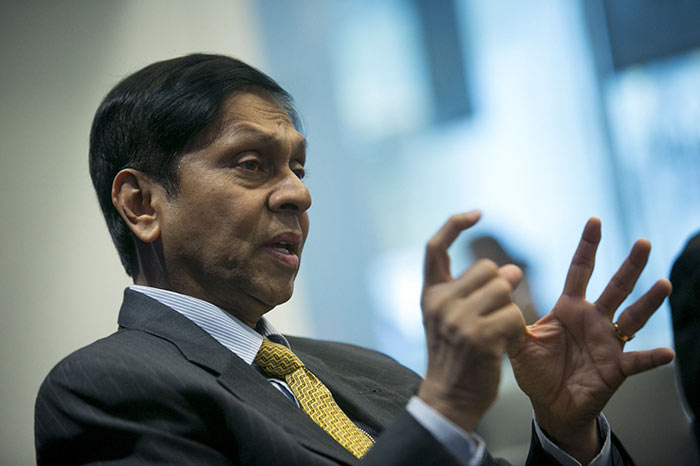Sri Lanka Central Bank to Outline Plan for Economic Stability

Ajith Nivard Cabraal | Photo by Scott Eells / Bloomberg
Sri Lanka’s central bank will Friday unveil a road map to restore economic stability in the island nation, amid doubts whether it can raise enough funds to service debt.
Ajith Nivard Cabraal, the Central Bank of Sri Lanka’s newly appointed governor, will release the document at 10 a.m. in Colombo. The focus is expected to be on reassuring stakeholders about the soundness of the macro-economic fundamentals.
“The government, bankers, importers, exporters, lenders, borrowers, investors, developers, service providers, industrial businesses, exchange houses, retailers, wholesalers and most importantly, the people of Sri Lanka must experience economic stability,” Cabraal had said in a statement Sept. 15. “It is then that undue fears are allayed.”
Sri Lanka’s dollar-denominated bonds are set for their biggest monthly drop since June with a loss of 4.3%, according to a JPMorgan Chase & Co. Index. That’s a reversal from the 2.2% gain in August after the South Asian nation repaid a $1 billion bond in late July.
The road map follows renewed doubts about Sri Lanka’s ability to service its debt, as the country faces depleted foreign exchange reserves. Efforts to shore up the pile through foreign currency loans haven’t succeeded yet, while earnings from sectors such as tourism – which until recently accounted for 5% of the economy — remain crimped because of the pandemic.
The country has so far resisted turning to the International Monetary Fund for help, after the lender abruptly ended a loan program last year.
Authorities have maintained that they have made arrangements to service another $1.5 billion of foreign bond payments that become due next year.
Some of the emergency measures to conserve dollars include a drive against hoarding of food stocks, curbs on imports, capital controls and a hike in interest rates. The reserves now offer less than the minimum desired three-months of import cover.
(Source: Bloomberg – By Anusha Ondaatjie)
Latest Headlines in Sri Lanka
- Sri Lanka receives over USD 7 Billion in remittances in 2025 December 13, 2025
- Sri Lanka Parliament summoned to meet on December 18 December 13, 2025
- Sri Lanka and Italy renew agreement on mutual recognition of driving licenses December 13, 2025
- Asoka Ranwala granted bail December 12, 2025
- MP Asoka Ranwala arrested for reckless driving December 12, 2025


